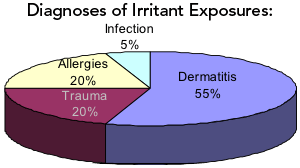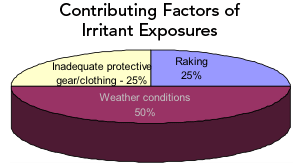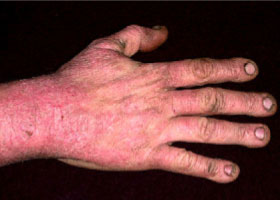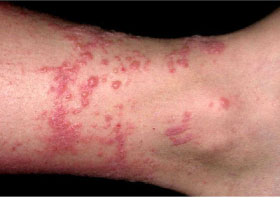Skin Irritation
Second most frequent work-related injury of blueberry harvesters
“Natural Irritants” include:
- Dust
- Sun
- Pollen
- Water
- Plants (i.e. peach fuzz, poison ivy, etc)
Skin Irritations include:
- Hives
- Eczema
- Dermatitis
- Burns



Poison Ivy / Oak / Sumac
Common natural irritants
- Form of allergic contact dermatitis.
- Urushiol is the chemical in the sap of poison ivy and oak plants that causes a rash, blisters, and an itch.
- Growers often spray herbicides beneath plants to keep undergrowth closely cropped. Poison ivy is immune to many of these chemicals, so competition from other plants is eliminated and poison ivy can spread freely.
Treatment:
- Immediately cleanse exposed skin with rubbing alcohol (alcohol removes the skin’s protection along with the urushiol).
- Wash skin with water.
- Take a shower with soap and warm water.
- Do not use soap before this point because it will pick up some urushiol from the surface
of the skin and spread it around. - Any tools, clothes, shoes, or other items that came into contact with the urushiol should be wiped off with alcohol and water.
Second most frequent work-related injury of blueberry harvesters
Exposure to Irritants – 15% of injuries and illnesses
- 50% of agricultural occupational skin disease is due to plants, trees, and natural vegetation.
- Less than 20% is due to reactions to pesticides and chemicals.
- Majority of occupational skin diseases affect hands, forearms, and other open skin areas, such as the face.
- 90% of most cases of occupational dermatitis are contact dermatitis.
- Contact dermatitis is the most common occupational illness in the US.
Irritant Contact Dermatitis: Most prevalent form of contact dermatitis. Occurs when a compound comes into direct contact with the skin, often more than once.

Allergic Contact Dermatitis: Less prevalent. Requires a sensitized immune system. Most common plant causing this reaction is poison oak/ivy.

Irritant reactions:
- Caused by contact with acids, alkaline materials, solvents, or other chemicals.
- Working around moisture, dirt, detergents, and chemicals increases risk.
- With enough exposure to the chemical, anyone can develop a reaction.
- Characterized by erythema and unilocular bullae, resulting from epithelial necrosis.
- Reaction usually resembles a burn.
Allergic reactions:
- Immune system must be sensitized to a chemical or material prior to reacting (not everyone reacts to certain chemicals).
- Skin reaction usually takes over 24 hours to develop and can last for a few weeks.
- Acute allergic contact dermatitis is characterized by microvesicles.
- Skin inflammation varies from mild irritation and redness to open sores.
Treatment:
All exposure sources must be detected and eliminated. Total removal from exposure often helps resolve reaction rapidly.
- Severe reaction: May take months to recover.
- Uncomplicated case: Reaction may resolve in 3-7 days, but skin will remain vulnerable for at least 3 weeks.